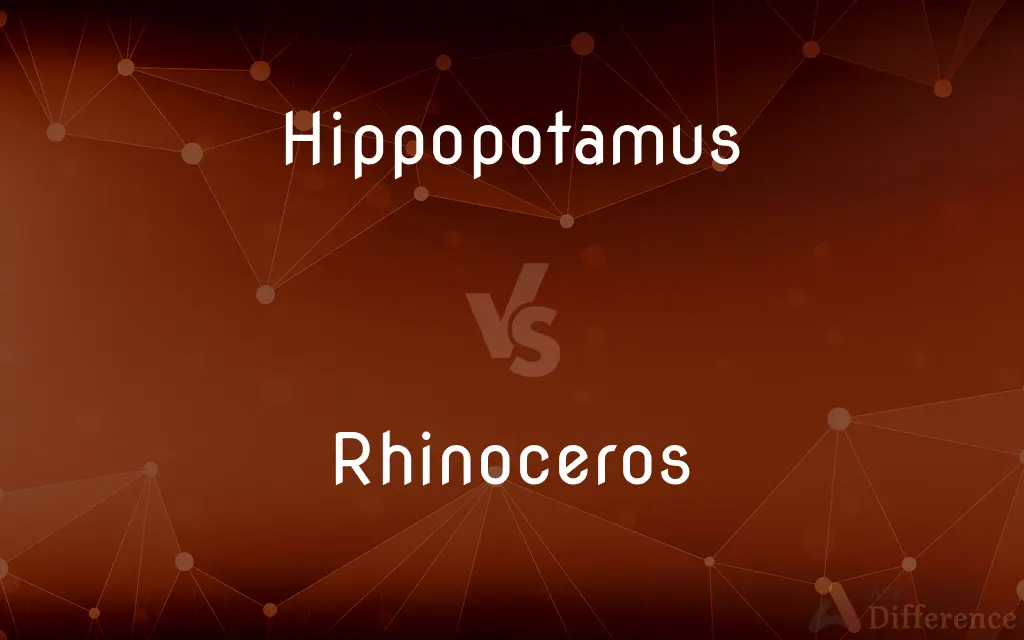Hippopotamus vs. Rhinoceros — What's the Difference?
By Tayyaba Rehman — Updated on October 3, 2023
Hippopotamus is a large, mostly herbivorous mammal that lives in freshwater habitats. Rhinoceros is a large, herbivorous mammal known for its thick skin and one or two horns on its nose.

Difference Between Hippopotamus and Rhinoceros
Table of Contents
ADVERTISEMENT
Key Differences
Hippopotamus is a semi-aquatic mammal native to sub-Saharan Africa. Rhinoceros, on the other hand, is a land-dwelling mammal found in both Africa and Asia.
The Hippopotamus, often shortened to 'hippo', spends a significant amount of its time in water and has adaptations like webbed feet. In contrast, the Rhinoceros is more adapted to terrestrial habitats and has thick, rough skin and hoofed feet.
Both the Hippopotamus and Rhinoceros are large herbivores, but their diets differ. While hippos primarily feed on grass, the Rhinoceros has a diet that includes leaves, branches, and shrubs.
One of the most distinguishing features of a Rhinoceros is its horn or horns, depending on the species. The Hippopotamus lacks horns but has large canine and incisor teeth which can be used defensively or in territorial disputes.
Though both Hippopotamus and Rhinoceros have few natural predators due to their size, they face threats from humans. The rhino is often poached for its horn, while the hippo's habitat is at risk due to human encroachment.
ADVERTISEMENT
Comparison Chart
Habitat
Semi-aquatic, found in freshwater habitats
Terrestrial, in savannahs, forests, and grasslands
Physical Feature
Large canine and incisor teeth
One or two horns on the nose
Diet
Primarily grass
Leaves, branches, and shrubs
Distribution
Sub-Saharan Africa
Africa and Asia
Threats from Humans
Habitat loss due to human encroachment
Poaching for its horn
Compare with Definitions
Hippopotamus
A large African mammal living near water
The hippopotamus basked in the sun by the river's edge.
Rhinoceros
A herbivore with thick, gray skin
The skin of a rhinoceros can be as thick as 5 centimeters.
Hippopotamus
A species with skin that secretes a pinkish fluid
The hippopotamus has a unique secretion that acts as a sunscreen.
Rhinoceros
An animal with poor eyesight but acute hearing
Though nearly blind, the rhinoceros detected movement by sound.
Hippopotamus
An herbivore with a massive body and short legs
The hippopotamus is one of Africa's most dangerous animals.
Rhinoceros
A species that's heavily poached for its horn
Conservationists are working to protect the rhinoceros from extinction.
Hippopotamus
A member of the family Hippopotamidae
The pygmy hippopotamus is a smaller relative of the common hippo.
Rhinoceros
A large mammal known for its horn or horns
The rhinoceros charged when it felt threatened.
Hippopotamus
A creature known for its wide-opening mouth
The child laughed seeing the hippopotamus yawn.
Rhinoceros
A member of the family Rhinocerotidae
The Indian rhinoceros is one of the five existing species of rhino.
Hippopotamus
The hippopotamus ( HIP-ə-POT-ə-məs; Hippopotamus amphibius), also called the hippo, common hippopotamus or river hippopotamus, is a large, mostly herbivorous, semiaquatic mammal and ungulate native to sub-Saharan Africa. It is one of only two extant species in the family Hippopotamidae, the other being the pygmy hippopotamus (Choeropsis liberiensis or Hexaprotodon liberiensis).
Rhinoceros
A rhinoceros (, from Greek rhinokerōs 'nose-horned', from rhis 'nose', and keras 'horn'), commonly abbreviated to rhino, is a member of any of the five extant species of odd-toed ungulates in the family Rhinocerotidae, as well as any of the numerous extinct species therein. Two of the extant species are native to Africa, and three to Southern Asia.
Hippopotamus
A large, chiefly aquatic African herbivorous mammal (Hippopotamus amphibius) having thick, dark, almost hairless skin, short legs with four toes, and a broad, wide-mouthed muzzle. Also called river horse.
Rhinoceros
Any of several large thick-skinned ungulate mammals of the family Rhinocerotidae, having one or two upright horns on the snout, and including the black rhinoceros (Diceros bicornis) and white rhinoceros (Ceratotherium simum) of Africa, the Indian rhinoceros (Rhinoceros unicornis) of India and Nepal, and the Javan rhinoceros (Rhinoceros sondaicus) and Sumatran rhinoceros (Dicerorhinus sumatrensis) of Southeast Asia.
Hippopotamus
The pygmy hippopotamus.
Rhinoceros
Any of several large herbivorous ungulates native to Africa and Asia of the five extant species in the three extant genera in the family Rhinocerotidae, with thick, gray skin and one or two horns on their snouts.
Hippopotamus
A large, semi-aquatic, herbivorous (plant-eating) African mammal (Hippopotamus amphibius; common hippopotamus).
Rhinoceros
(paleontology) A member of the superfamily Rhinocerotoidea, including hornless members of the extinct genus Paraceratherium.
Hippopotamus
Any similar animal of the family Hippopotamidae.
Rhinoceros
Any pachyderm belonging to the genera Rhinoceros, Atelodus, and several allied genera of the family Rhinocerotidæ, of which several living, and many extinct, species are known. They are large and powerful, and usually have either one or two stout conical median horns on the snout.
Hippopotamus
A large, amphibious, herbivorous mammal (Hippopotamus amphibius), common in the rivers of tropical Africa. It is allied to the hogs, and has a very thick, naked skin, a thick and square head, a very large muzzle, small eyes and ears, thick and heavy body, and short legs. It is supposed to be the behemoth of the Bible. Called also zeekoe, and river horse. A smaller species (Hippopotamus Liberiencis) inhabits Western Africa.
Rhinoceros
Massive powerful herbivorous odd-toed ungulate of southeast Asia and Africa having very thick skin and one or two horns on the snout
Hippopotamus
Massive thick-skinned herbivorous animal living in or around rivers of tropical Africa
Common Curiosities
Do hippos have a natural sunscreen?
Yes, the hippopotamus secretes a pinkish fluid that acts as a natural sunscreen.
Is the hippopotamus aggressive?
Yes, despite its docile appearance, the hippopotamus can be one of Africa's most aggressive animals.
Which is larger, a hippopotamus or a rhinoceros?
Both are large, but the white rhinoceros can be larger than the hippopotamus in terms of weight.
Are both the hippopotamus and rhinoceros herbivores?
Yes, both the hippopotamus and rhinoceros are herbivores, though their diets differ.
Are all rhinoceroses gray?
While most rhinoceros species are grayish, their exact color can vary depending on the species and habitat.
Do both animals have a significant impact on their ecosystem?
Yes, both the hippopotamus and rhinoceros play crucial roles in shaping their respective ecosystems.
Which has a better sense of hearing, the hippopotamus or the rhinoceros?
The rhinoceros has an acute sense of hearing, compensating for its poor eyesight.
How many species of rhinoceros are there?
There are five species of rhinoceros: white, black, Indian, Javan, and Sumatran.
Why is the rhinoceros often poached?
The rhinoceros is poached primarily for its horn, which is in demand for traditional medicine and as a status symbol.
Which animal spends more time in water?
The hippopotamus spends a significant amount of time in water, compared to the mostly land-dwelling rhinoceros.
How fast can a hippopotamus run?
Despite its size, a hippopotamus can run up to 19-25 mph on land for short distances.
Is the hippopotamus an aquatic animal?
No, the hippopotamus is semi-aquatic, living near freshwater but also venturing on land.
Are rhinoceros horns made of bone?
No, rhinoceros horns are made of keratin, the same material as human fingernails.
Is the skin of a rhinoceros tougher than that of a hippopotamus?
The rhinoceros has particularly thick and rough skin, whereas the hippopotamus has smoother skin that's more sensitive to the sun.
Which of the two is more endangered?
While both face threats, certain species of rhinoceros, like the Javan and Sumatran, are critically endangered.
Share Your Discovery

Previous Comparison
Cereal vs. Serial
Next Comparison
Strength vs. StrongnessAuthor Spotlight
Written by
Tayyaba RehmanTayyaba Rehman is a distinguished writer, currently serving as a primary contributor to askdifference.com. As a researcher in semantics and etymology, Tayyaba's passion for the complexity of languages and their distinctions has found a perfect home on the platform. Tayyaba delves into the intricacies of language, distinguishing between commonly confused words and phrases, thereby providing clarity for readers worldwide.














































